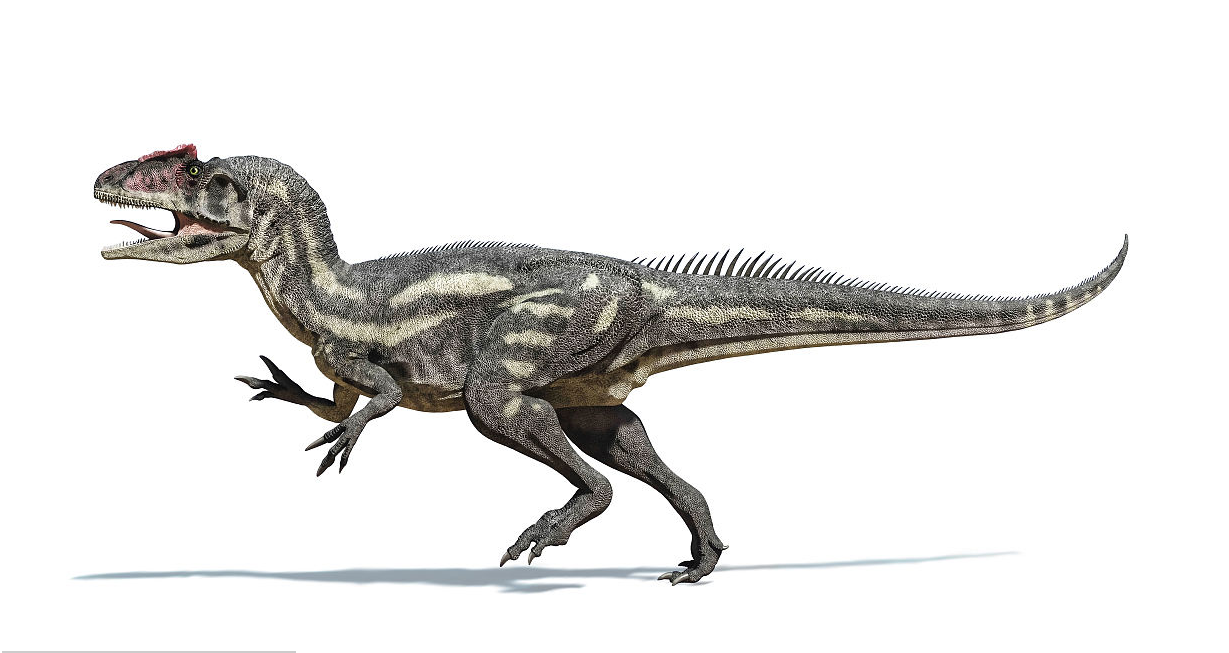Dinosaur Knowledge Tips Allosaurus
Release time:2018/3/5 11:24:00

Allosaurus () is a genus of large theropod dinosaur that lived 155 to 150 million years ago during the late Jurassic period (Kimmeridgian to early Tithonian). The name "Allosaurus" means "different lizard". It is derived from the Greek ἄλλος/allos ("different, other") and σαῦρος/sauros ("lizard / generic reptile"). The first fossil remains that could
definitively be ascribed to this genus were described in 1877 by
paleontologist Othniel Charles Marsh. These remains became known as Antrodemus. As one of the first well-known theropod dinosaurs, it has long attracted attention outside of paleontological circles. Indeed, it has been a top feature in several films and documentaries about prehistoric life.
Allosaurus was a large bipedal predator. Its skull was large and equipped with dozens of sharp, serrated teeth.
It averaged 8.5 m (28 ft) in length, though fragmentary remains suggest
it could have reached over 12 m (39 ft). Relative to the large and
powerful hindlimbs, its three-fingered forelimbs were small, and the
body was balanced by a long and heavily muscled tail. It is classified
as an allosaurid, a type of carnosaurian theropod dinosaur. The genus has a complicated taxonomy, and includes an uncertain number of valid species, the best known of which is A. fragilis. The bulk of Allosaurus remains have come from North America's Morrison Formation, with material also known from Portugal and possibly Tanzania. It was known for over half of the 20th century as Antrodemus, but a study of the copious remains from the Cleveland-Lloyd Dinosaur Quarry brought the name "Allosaurus" back to prominence and established it as one of the best-known dinosaurs.
As the most abundant large predator in the Morrison Formation, Allosaurus was at the top of the food chain, probably preying on contemporaneous large herbivorous dinosaurs, and perhaps even other predators. Potential prey included ornithopods, stegosaurids, and sauropods. Some paleontologists interpret Allosaurus as having had cooperative social behavior,
and hunting in packs, while others believe individuals may have been
aggressive toward each other, and that congregations of this genus are
the result of lone individuals feeding on the same carcasses. It may
have attacked large prey by ambush, using its upper jaw like a hatchet.

Allosaurus was a typical large theropod, having a massive skull on a short neck, a long tail and reduced forelimbs. Allosaurus fragilis, the best-known species, had an average length of 8.5 m (28 ft), with the largest definitive Allosaurus specimen (AMNH 680) estimated at 9.7 meters (32 feet) long, and an estimated weight of 2.3 metric tons (2.5 short tons). In his 1976 monograph on Allosaurus, James H. Madsen mentioned a range of bone sizes which he interpreted to show a maximum length of 12 to 13 m (39 to 43 ft). As with dinosaurs in general, weight estimates are debatable, and since
1980 have ranged between 1,500 kilograms (3,300 pounds), 1,000 to
4,000 kg (2,200 to 8,800 lb), and 1,010 kilograms (2,230 pounds) for modal adult weight (not maximum). John Foster, a specialist on the Morrison Formation, suggests that 1,000 kg (2,200 lb) is reasonable for large adults of A. fragilis, but that 700 kg (1,500 lb) is a closer estimate for individuals represented by the average-sized thigh bones he has measured. Using the subadult specimen nicknamed "Big Al", researchers using
computer modelling arrived at a best estimate of 1,500 kilograms
(3,300 lb) for the individual, but by varying parameters they found a
range from approximately 1,400 kilograms (3,100 lb) to approximately
2,000 kilograms (4,400 lb).
Several gigantic specimens have been attributed to Allosaurus, but may in fact belong to other genera. The closely related genus Saurophaganax (OMNH 1708) reached perhaps 10.9 m (36 ft) in length, and its single species has sometimes been included in the genus Allosaurus as Allosaurus maximus, though recent studies support it as a separate genus. Another potential specimen of Allosaurus, once assigned to the genus Epanterias (AMNH 5767), may have measured 12.1 meters (40 feet) in length. A more recent discovery is a partial skeleton from the Peterson Quarry in Morrison rocks of New Mexico; this large allosaurid may be another individual of Saurophaganax.

Allosaurus was an allosaurid, a member of a family of large theropods within the larger group Carnosauria. The family name Allosauridae was created for this genus in 1878 by Othniel Charles Marsh, but the term was largely unused until the 1970s in favor of Megalosauridae, another family of large theropods that eventually became a wastebasket taxon. This, along with the use of Antrodemus for Allosaurus during the same period, is a point that needs to be remembered when searching for information on Allosaurus in publications that predate James Madsen's 1976 monograph. Major
publications using the name "Megalosauridae" instead of "Allosauridae"
include Gilmore, 1920, von Huene, 1926, Romer, 1956 and 1966, Steel, 1970, and Walker, 1964.
Following the publication of Madsen's influential monograph,
Allosauridae became the preferred family assignment, but it too was not
strongly defined. Semi-technical works used Allosauridae for a variety
of large theropods, usually those that were larger and better-known than
megalosaurids. Typical theropods that were thought to be related to Allosaurus included Indosaurus, Piatnitzkysaurus, Piveteausaurus, Yangchuanosaurus, Acrocanthosaurus, Chilantaisaurus, Compsosuchus, Stokesosaurus, and Szechuanosaurus. Given modern knowledge of theropod diversity and the advent of cladistic study of evolutionary relationships, none of these theropods is now recognized as an allosaurid, although several, like Acrocanthosaurus and Yangchuanosaurus, are members of closely related families.
from Wikipedia